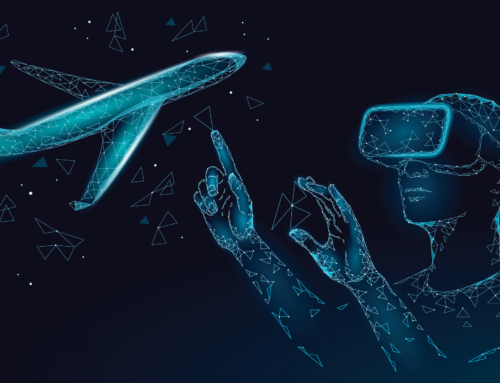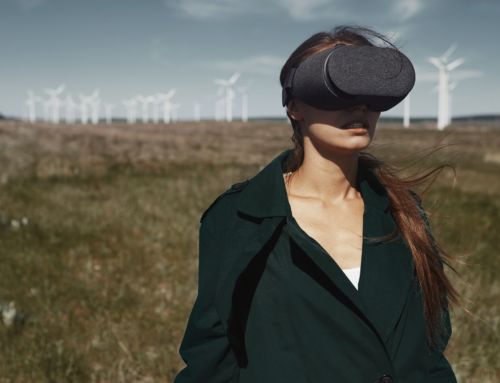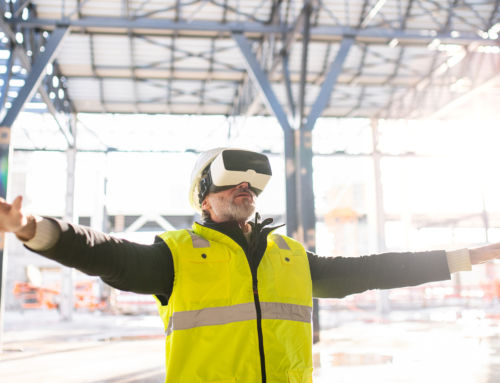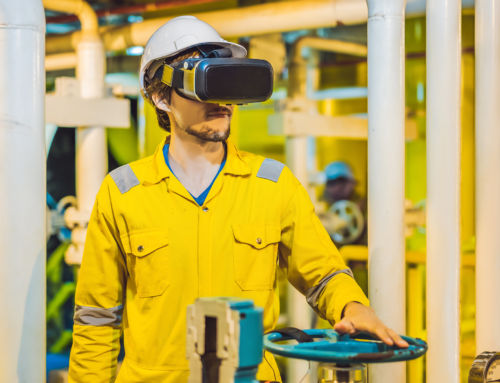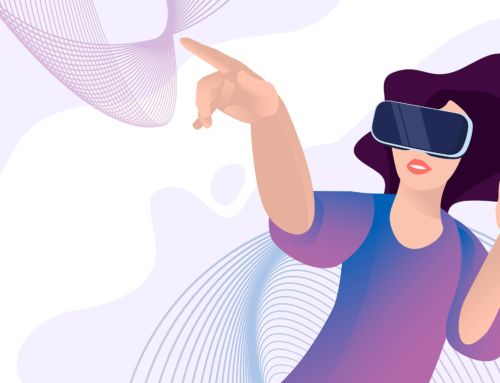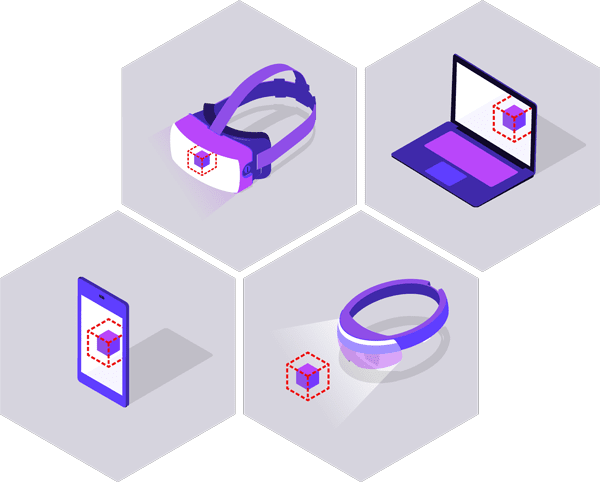Training in VR offers unique and exciting ways to learn new skills. But if you’re thinking of introducing immersive technologies into your company’s training portfolio, how can you ensure that it offers a viable, long term solution to your skills needs, rather than being seduced by gimmicky tech?
As VR technologies become ever more sophisticated, there is tangible evidence of the benefits of immersive training. By giving employees the chance to experience hands-on, practical training in a safe virtual environment, skills are learned faster, retention of learning is improved and workplace productivity and safety can increase. What’s more, there are cost benefits too.

Five key benefits of VR training
1. Improved learning and performance
The 70/20/10 model for learning and development highlights that people learn from job-related experiences, as 70 percent of what people learn is experiential, compared with 20% learned from others and 10% through formal learning.
Learning by doing is therefore a far more efficient and effective way of learning new skills, retaining information and changing behaviours. The power of virtual reality lies in its potential for creating a realistic space where learners can get hands-on experience that focuses on specific work-related tasks. Crucially, it allows them to make mistakes, get instant feedback through performance related metrics and easily repeat exercises numerous times to quickly improve proficiency. This includes:
· Highly skilled, technical training
Advances in VR platforms means that hyper real environments and scenarios can be developed. This means that complex technical tasks can be easily replicated, so that training exercises truly reflect daily working practices. Learners are able to repeat these virtual tasks, building muscle memory that helps with retention of learning, which can then be implemented in real life. For example, healthcare practitioners can gain the chance to learn and practice intricate surgical procedures in a risk-free environment, ultimately leading to better patient care.
· Process driven skills
Companies are also embracing VR to improve efficiencies by addressing process driven skills. The gamification of procedures such as preparing food at KFC, through to DHL warehouse box loading allows employees to problem solve and work smarter by learning in a fun and results-driven environment. It also allows businesses to introduce consistency of working practices across different sites and countries.
· Business and soft skills training
The benefits of VR training for soft skills, such as customer service, delivering speeches and social behaviour in the workplace are increasingly being recognised. VR removes the need for awkward and uncomfortable role playing scenarios with colleagues, which can be counter-productive for learning.
· Team collaboration
Moreover, VR can help to improve team performance by creating collaborative training experiences that improve workflows by giving teams a space to address skills issues around interdependent tasks.

2. Making the impossible possible
For many sectors, such as defence, oil & gas, aviation, manufacturing and healthcare, learning on-the-job is just not viable. Hostile working environments, non-stop production lines and learning life-threatening procedures make practical training far too high risk or operationally impossible. Paradoxically, in many of these cases, being fully trained is job-critical, as failure could have devastating consequences.
In these instances, VR can replicate hazardous scenarios in a safe, but realistic learning environment to practice highly skilled and risky tasks. Learners can effectively and efficiently hone their skills by failing, learning from their mistakes and repeating exercises. Additionally, learners can work more confidently, mitigating costly mistakes and making workplaces safer.
Read about Future Visual and IATA’s award winning RampVR, the aviation industry’s first VR training platform for ground operations.
3. Speeding up the learning process
In business, time is money. Training employees quickly and efficiently contributes to increased company productivity – and fully immersive training experiences give learners the chance to learn new skills faster – and retain that knowledge.
Virtual reality also creates a distraction-free environment – allowing learners to learn smarter and faster. A study by Microsoft highlighted that humans’ attention span is worse than goldfish, finding that we generally lose concentration after eight seconds – which isn’t conducive to learning effectively. By donning a VR headset, we can block out real world distractions so that we are more likely to fully concentrate on the task in hand.
4. Reducing costs
The long-term cost benefits of introducing VR training make good business. The initial necessary investment in hardware is outweighed by both direct and indirect savings. Once your course is developed, costs of rolling it out at scale are minimal, as it removes the need to hold repeat courses and potentially hefty trainer fees.
Furthermore, there are also tangible indirect cost savings from minimising downtime and removing the need to halt production, through to increasing productivity by having better trained and proficient employees.
5. Remote training and accessibility: great for your company, great for the planet
The great thing about virtual training is that you can be virtually anywhere in the real world to do it. For VR, the need to bring employees together at the same time, in the same physical space is irrelevant. For many employees, this makes training more accessible, as it can take place anywhere – even if undertaking team training with others.
For companies based across multiple sites or even countries, in addition to those with an increasing number of remote workers, VR training has a significant impact on travel and accommodation costs, as well as the additional downtime that needs to be factored in for employees travelling to attend their training. A reduction in travel also has a huge positive impact on a company’s environmental impact.
Read more to find out about how virtual reality has the power to revolutionise corporate training.

Conclusion
Virtual reality offers unique, engaging and fun ways to train in a safe, but realistic environment. It offers tangible benefits for individual learners, streamlining workflows through teams training together and contributing to a safer and more productive workplace. That’s far from a gimmick – it’s good business sense.
To get in touch to discuss your next project contact us here: https://www.futurevisual.com/contact/
Training in VR offers unique and exciting ways to learn new skills. But if you’re thinking of introducing immersive technologies into your company’s training portfolio, how can you ensure that it offers a viable, long term solution to your skills needs, rather than being seduced by gimmicky tech?
As VR technologies become ever more sophisticated, there is tangible evidence of the benefits of immersive training. By giving employees the chance to experience hands-on, practical training in a safe virtual environment, skills are learned faster, retention of learning is improved and workplace productivity and safety can increase. What’s more, there are cost benefits too.

Five key benefits of VR training
1. Improved learning and performance
The 70/20/10 model for learning and development highlights that people learn from job-related experiences, as 70 percent of what people learn is experiential, compared with 20% learned from others and 10% through formal learning.
Learning by doing is therefore a far more efficient and effective way of learning new skills, retaining information and changing behaviours. The power of virtual reality lies in its potential for creating a realistic space where learners can get hands-on experience that focuses on specific work-related tasks. Crucially, it allows them to make mistakes, get instant feedback through performance related metrics and easily repeat exercises numerous times to quickly improve proficiency. This includes:
· Highly skilled, technical training
Advances in VR platforms means that hyper real environments and scenarios can be developed. This means that complex technical tasks can be easily replicated, so that training exercises truly reflect daily working practices. Learners are able to repeat these virtual tasks, building muscle memory that helps with retention of learning, which can then be implemented in real life. For example, healthcare practitioners can gain the chance to learn and practice intricate surgical procedures in a risk-free environment, ultimately leading to better patient care.
· Process driven skills
Companies are also embracing VR to improve efficiencies by addressing process driven skills. The gamification of procedures such as preparing food at KFC, through to DHL warehouse box loading allows employees to problem solve and work smarter by learning in a fun and results-driven environment. It also allows businesses to introduce consistency of working practices across different sites and countries.
· Business and soft skills training
The benefits of VR training for soft skills, such as customer service, delivering speeches and social behaviour in the workplace are increasingly being recognised. VR removes the need for awkward and uncomfortable role playing scenarios with colleagues, which can be counter-productive for learning.
· Team collaboration
Moreover, VR can help to improve team performance by creating collaborative training experiences that improve workflows by giving teams a space to address skills issues around interdependent tasks.

2. Making the impossible possible
For many sectors, such as defence, oil & gas, aviation, manufacturing and healthcare, learning on-the-job is just not viable. Hostile working environments, non-stop production lines and learning life-threatening procedures make practical training far too high risk or operationally impossible. Paradoxically, in many of these cases, being fully trained is job-critical, as failure could have devastating consequences.
In these instances, VR can replicate hazardous scenarios in a safe, but realistic learning environment to practice highly skilled and risky tasks. Learners can effectively and efficiently hone their skills by failing, learning from their mistakes and repeating exercises. Additionally, learners can work more confidently, mitigating costly mistakes and making workplaces safer.
Read about Future Visual and IATA’s award winning RampVR, the aviation industry’s first VR training platform for ground operations.
3. Speeding up the learning process
In business, time is money. Training employees quickly and efficiently contributes to increased company productivity – and fully immersive training experiences give learners the chance to learn new skills faster – and retain that knowledge.
Virtual reality also creates a distraction-free environment – allowing learners to learn smarter and faster. A study by Microsoft highlighted that humans’ attention span is worse than goldfish, finding that we generally lose concentration after eight seconds – which isn’t conducive to learning effectively. By donning a VR headset, we can block out real world distractions so that we are more likely to fully concentrate on the task in hand.
4. Reducing costs
The long-term cost benefits of introducing VR training make good business. The initial necessary investment in hardware is outweighed by both direct and indirect savings. Once your course is developed, costs of rolling it out at scale are minimal, as it removes the need to hold repeat courses and potentially hefty trainer fees.
Furthermore, there are also tangible indirect cost savings from minimising downtime and removing the need to halt production, through to increasing productivity by having better trained and proficient employees.
5. Remote training and accessibility: great for your company, great for the planet
The great thing about virtual training is that you can be virtually anywhere in the real world to do it. For VR, the need to bring employees together at the same time, in the same physical space is irrelevant. For many employees, this makes training more accessible, as it can take place anywhere – even if undertaking team training with others.
For companies based across multiple sites or even countries, in addition to those with an increasing number of remote workers, VR training has a significant impact on travel and accommodation costs, as well as the additional downtime that needs to be factored in for employees travelling to attend their training. A reduction in travel also has a huge positive impact on a company’s environmental impact.
Read more to find out about how virtual reality has the power to revolutionise corporate training.

Conclusion
Virtual reality offers unique, engaging and fun ways to train in a safe, but realistic environment. It offers tangible benefits for individual learners, streamlining workflows through teams training together and contributing to a safer and more productive workplace. That’s far from a gimmick – it’s good business sense.
To get in touch to discuss your next project contact us here: https://www.futurevisual.com/contact/








